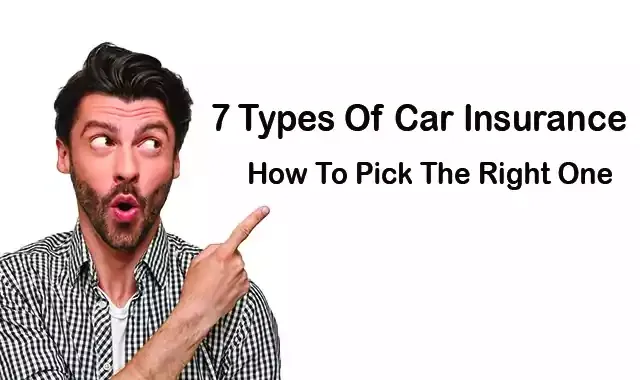If you’ve been left scratching your head about what your car insurance policy covers, you’re not alone. Basically, car insurance coverage is what you’re protected from if you get in a car accident. When you buy your policy, each coverage that you buy lists the damage it pays for.
 |
| 7 Types Of Car Insurance |
You’ll see a wide range of coverage that car insurance companies
offer — but these are the 7 most common ones. 7 Types Of Cheap Car Insurance, when
choosing coverage, start with what’s required by your state and your car loan
if you financed your car.
1- Liability coverage:
Liability is broken down into two types:
- Bodily injury liability.
- Property damage liability.
Pays for injuries to OTHER drivers, passengers, or even
pedestrians if you’re responsible for an accident. Property damage liability
kicks in if you damage someone else’s property, like the other driver’s car.
Liability also covers legal expenses if someone takes you to court.
The limitations on your liability coverage Because all of
these costs can get expensive, your insurance company puts a cap on how much it
will pay, which is called a coverage limit. You’ll see your liability limits
written as 50/100/50.
The first two numbers show the maximum your insurance will
pay for injuries. Here, your insurance would pay $50,000 for each person
injured, and a total of $100,000 for all injuries in the accident, The third
number shows the maximum your insurance will pay for property damage, a.k.a.
the other driver’s car. Here, insurance will pay up to $50,000 worth of car
damage.
So, to recap, your insurance would pay $50,000 for each
person injured, $100,000 total for all injuries per accident, and $50,000 for
the other driver’s car damage.
Keep in mind that paying for someone else’s damage can get expensive,
especially if there are several passengers or if you damage a valuable car like
a Tesla or Porsche. So, consider higher
limits than your state requires like 100/300/100.
2- Personal injury protection (PIP):
This pays for YOUR
medical bills if you get injured in an accident, including health insurance
copays or deductibles.
It may also pay for lost income if you’re out of work, as
well as childcare, nursing care, housekeeping, and other services until you
recover. The exact expenses it covers depend on your state and the insurance
company.
3- Medical payments coverage:
This is similar to PIP but it only pays for medical bills,
not lost income. These types of medical coverage can be helpful if you have a
high health insurance deductible.
4- Uninsured or underinsured motorist coverage
In fact, some states require it. Uninsured motorist coverage
applies to YOUR car repairs or medical bills if you get hit by a driver who
doesn’t have enough insurance.
So, if the driver responsible only has $15,000 in property
damage liability and your car is worth $20,000, underinsured motorist property
damage can kick in to cover the rest of your car’s repairs.
Uninsured or underinsured motorist coverage is also split up
into two parts for injuries or property damage. So similar to liability
coverage, you’ll choose the maximum that your insurance will pay for your car
damage and your injuries, like 50/100/25.
5- Collision coverage
Which pays for YOUR car’s repairs if you cause an accident.
Remember, if you’re the one responsible, your liability pays for the OTHER
driver’s car repairs — but it doesn’t kick in for your car. That’s where
collision coverage comes in.
6- Comprehensive coverage
Although comprehensive here doesn’t mean wide
protection.
Comprehensive coverage pays for car damage that’s not
related to a collision with another car. So, what does it pay for?
Comprehensive kicks in for storm damage, vandalism, hitting an animal, a tree
falling on your car, or replacing your car if it’s stolen.
If you have a car loan, your lender probably requires both
comprehensive and collision coverage. If you don’t have a loan, you most likely
need collision coverage, unless you have enough savings to replace your car on
your own. For comprehensive, think about how likely it is for your car to get
damaged by a storm, vandalism, or theft.
However, if you own an older car, buying comprehensive and
collision might not be worth it if you’d pay more than your car is worth.
7- Gap insurance
While you might benefit from gap insurance, it’s not always
necessary.
If you total your car in an accident, your insurance company
pays out your car’s market value, which includes depreciation. The problem is that,
if your car loses value too quickly, your insurance check may not pay off your
car loan.
So, let’s say you buy a brand-new car for $20,000 and it
gets totaled a year later. At that point, your car might only be worth $16,000,
and that’s what your insurance will pay. But if you owe $17,000 on your loan,
you’ll have to pay the extra $1K out of
pocket unless you have gap insurance.
On the flip side, if your car is worth $16,000 and your loan
balance is only $15,000, you’ll have money left over when you get the insurance
check. Since there’s no gap between what your car is worth and what’s left on
your loan, you don’t need gap insurance.
You have a better chance of not needing gap insurance if
you’ve made a big down payment or extra payments on your loan, or if you have a
short-term car loan like two years.
To recap, you need at least the coverage that’s required by
your state and your car loan to hit.
The road. But when looking at add-ons, everyone’s needs are
a little different. To get the right level of vehicle insurance, think through the
damage that’s most likely to happen, such as you causing a car accident or a
storm damaging your car. Then, balance getting protection for that damage with
what you can comfortably afford.

